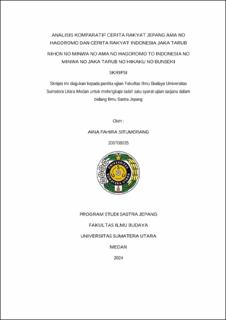Analisis Komparatif Cerita Rakyat Jepang Ama No Hagoromo dan Cerita Rakyat Indonesia Jaka Tarub Nihon No Minwa No Ama No Hagoromo To Indonesia No Minwa No Jaka Tarub No Hikaku No Bunseki
Comparative Analysis of Japanese Folklore Ama No Hagoromo and Indonesian Folklore Jaka Tarub

Date
2024Author
Situmorang, Aina Fahira
Advisor(s)
Kusdiyana, Eman
Alimansyar
Metadata
Show full item recordAbstract
This research focuses on the Comparative Analysis of Japanese Folklore Ama No Hagoromo and Indonesian Folklore Jaka Tarub. The author chose this title because the author is interested in Japanese folktales Ama No Hagoromo and Jaka Tarub which are two folktales that come from different countries, but have almost the same story structure. These two folktales have a similar theme, which tells the main character who is an ordinary young man, but gets a wife who is an angel from heaven. In the end, the young man had to lose his wife because his lie was known by his wife. This research method uses a qualitative method with a structural approach to find out the similarities and differences in themes, characters, settings, plot, and mandate contained in the two folktales. After conducting the analysis, the author will compare the intrinsic elements of the two stories using the comparative literature method. The results of this study show that there are similarities in the theme, namely both have a major theme, namely love at first sight and the minor theme is crime (stealing), in the characters, namely both have main characters and additional characters, in the plot, namely both have a forward plot, in the setting, namely both have a place setting and time setting, and in the mandate, namely both the message conveyed must be honest. The basic differences in the two folktales to be compared in local wisdom are in the Ama No Hagoromo folktale the angels who appear are eight while in the Jaaka Taarub folktale the angels who appear are seven, in the Ama No Hagoromo folktale the angel's shawl is white while in the Jaka Tarub folktale the angel's shawl is red. The conclusion of this research is that folktales are not only used as entertainment and are only seen as oral traditions of children's bedtime. However, it can try to understand the positive values obtained as learning in everyday life.
Collections
- Undergraduate Theses [593]
